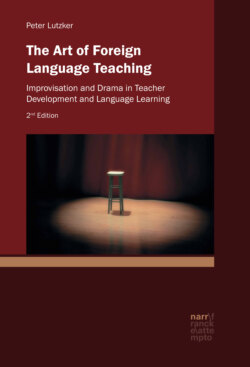Читать книгу The Art of Foreign Language Teaching - Peter Lutzker - Страница 52
На сайте Литреса книга снята с продажи.
5 Discovering the Clown Within: Background to Clowning Courses with Vivian Gladwell 5.1 Background: Vivian Gladwell and Bataclown
ОглавлениеVivian Gladwell was born in England in 1953. While studying Sociology at the University of London, he first discovered clowning. He later trained with the Bataclown in France and worked with them professionally for many years. In 1990 he founded the Clowning Institute Nose to Nose. He regularly gives clowning courses throughout Europe and North America for a wide range of professionals including actors, teachers, doctors and social workers. He also teaches English at the University of Toulouse.
The renowned French Bataclown group works in the tradition of theatre clowning associated with the school of Jacque Lecoq, based on improvisation and the mask. Lecoq’s work is considered seminal in the development of clowning, having its origins in the techniques of the Commedia dell’ Arte and differing markedly from the type of clowning allied to the circus tradition.219 In adopting Lecoq’s approach and techniques, Bataclown modified them insofar as they did not solely aim to train professionals, but also used these principles and methods in working artistically with people who did not intend to become clowns. In this context, they placed their emphasis not on first developing technique, as Lecoq had done, but on making authenticity the main focus of their work and only gradually moving towards technique.
Clowning in the tradition of Bataclown teaches people to improvise within the conventions of clowning, ‘protected’ by costumes and a red nose and, at the same time, encourages them to express exactly how they feel while improvising. This is an essential distinction between clowning improvisations and, for example, theatre improvisations which instead strive for a coherence and believability which are not required in clowning. In Gladwell’s words,
In theatre improvisations there is a tendency to try and be coherent in the role you play. So, if you play a king, in order to be believable in that role you need to have a degree of coherence. In clowning, it doesn’t matter if you are still believable or coherent because the moment you are incoherent or “out of role” it is still clowning…where you reveal how you feel about playing the role of the king, whether you are enjoying the role or not, whether you feel you are good at it. That twinkle in the eye that says to the audience: “Look I am having a great time here” is what clowning is about. It reveals what is underneath the convention of playing a role. So, say an actor has a hard time with imitating an Italian accent. If you are trying to be convincing you wouldn’t want your audience to know you were having a hard time because it would break the spell and they might not believe in the story or your role anymore. In clowning that is exactly what we want. We want to be taken in the story and yet we also know that the truth is that it is an actor playing a role. You are at the same time in the convention of the theatre and the truth. The twinkle in the eye reveals the truth and we all laugh because we recognize that truth.220
Thus, as will become apparent in both the descriptions of the workshops and in the feedback of the participants, learning to fully play with the possibilities of improvising a story and yet still being able to also step out of that story and reveal one’s true feelings is an essential part of clowning. Within the playful conventions of clowning and while utilizing their imaginative capacities to act out stories, participants are also encouraged to become aware of their fears, insecurities and feelings and to give them truthful, visible expression. Learning to accept and then express these feelings on stage encourages a degree of personal authenticity which acting does not generally permit. In fact, it is precisely the problems and difficulties that occur in the course of an improvisation that often present the richest opportunities. It is the emotional transparency of the clown, whom one sees struggling to overcome difficulties and living through a problem, that we find most genuinely moving.
The dimensions of self-awareness and self-expression which are called upon have implications which can go well beyond clowning. Thus, unsurprisingly, in both the concepts and methods of Bataclown there are connections to different fields, based on a similar understanding of the significance of authenticity in achieving balance and health.
